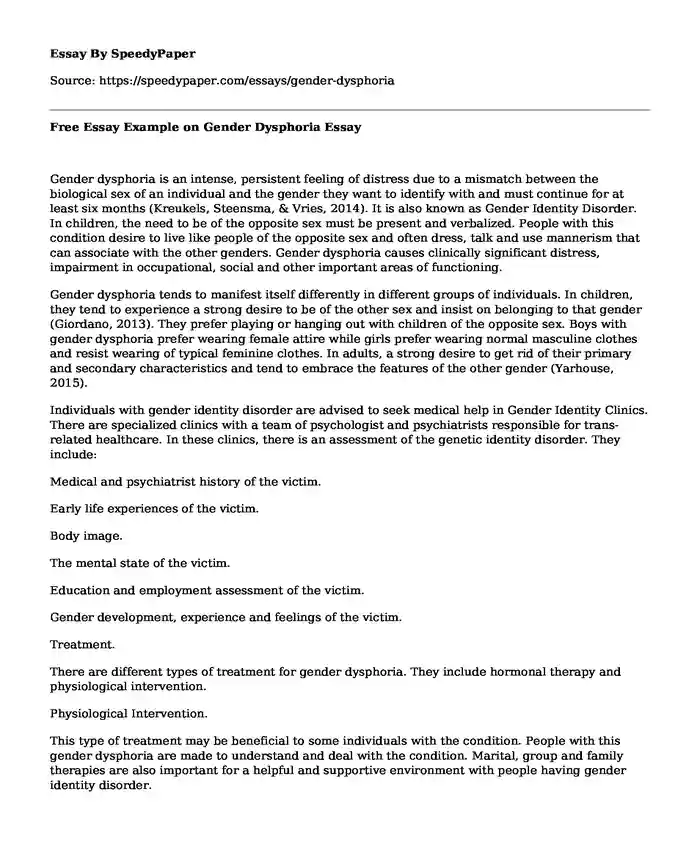
| Type of paper: | Essay |
| Categories: | Gender Psychology |
| Pages: | 3 |
| Wordcount: | 683 words |
Gender dysphoria is an intense, persistent feeling of distress due to a mismatch between the biological sex of an individual and the gender they want to identify with and must continue for at least six months (Kreukels, Steensma, & Vries, 2014). It is also known as Gender Identity Disorder. In children, the need to be of the opposite sex must be present and verbalized. People with this condition desire to live like people of the opposite sex and often dress, talk and use mannerism that can associate with the other genders. Gender dysphoria causes clinically significant distress, impairment in occupational, social and other important areas of functioning.
Gender dysphoria tends to manifest itself differently in different groups of individuals. In children, they tend to experience a strong desire to be of the other sex and insist on belonging to that gender (Giordano, 2013). They prefer playing or hanging out with children of the opposite sex. Boys with gender dysphoria prefer wearing female attire while girls prefer wearing normal masculine clothes and resist wearing of typical feminine clothes. In adults, a strong desire to get rid of their primary and secondary characteristics and tend to embrace the features of the other gender (Yarhouse, 2015).
Individuals with gender identity disorder are advised to seek medical help in Gender Identity Clinics. There are specialized clinics with a team of psychologist and psychiatrists responsible for trans-related healthcare. In these clinics, there is an assessment of the genetic identity disorder. They include:
Medical and psychiatrist history of the victim.
Early life experiences of the victim.
Body image.
The mental state of the victim.
Education and employment assessment of the victim.
Gender development, experience and feelings of the victim.
Treatment.
There are different types of treatment for gender dysphoria. They include hormonal therapy and physiological intervention.
Physiological Intervention.
This type of treatment may be beneficial to some individuals with the condition. People with this gender dysphoria are made to understand and deal with the condition. Marital, group and family therapies are also important for a helpful and supportive environment with people having gender identity disorder.
Hormone Therapy
Hormone therapy is the best treatment for the condition especially in adolescents before they develop secondary sexual characteristics. This mode of treatment it entails Individuals taking hormones testosterone or estrogen to enable them to have traits of the sex that they identify with (Trombetta, Liguori, & Bertolotto, 2015). However, hormone therapy has some physiological effects.
Physiological Effects of Hormone Therapy for Transmen.
Hormone therapy results to genital changes transmen. Genital changes such as an increase in the size of the clitoris induced by the testosterone are the first to be noticed by the transmen. This change onsets early by 3 to 4 months and is complete by the end of a year with the final length of the clitoris being 4 to 5 cm. An increase in stromal tissue is also experienced together with the formation of cysts to the changes witnessed in polycystic ovarian syndrome (Seal, 2015). These changes significance is unclear and occurs after six months of the therapy. Testosterone also leads to the production of erythropoietin and therefore leads to the increase of production of red blood cells. If testosterone used in excess may result in increased insulin resistance. Athletes abusing steroids mostly experience this.
However, it is crucial for individuals with gender identity disorder to put into consideration before undergoing hormonal therapy. They should consider things such as long-term risks, irreversible complications e.g. infertility, its impact on the physical health, choice of product, dosage and the method of delivery.
References
Giordano, S. (2013). Children with gender identity disorder (1st ed.). New York: Routledge.
Kreukels, B., Steensma, T., & Vries, A. (2014). Gender dysphoria and disorders of sex development(1st ed.). New York: Springer.
Seal, L. (2015). A review of the physical and metabolic effects of cross-sex hormonal therapy in the treatment of gender dysphoria. Annals Of Clinical Biochemistry: An International Journal Of Biochemistry And Laboratory Medicine, 53(1), 10-20. http://dx.doi.org/10.1177/0004563215587763
Trombetta, C., Liguori, G., & Bertolotto, M. (2015). Management of gender dysphoria (1st ed.). Milan: Springer.
Yarhouse, M. (2015). Understanding gender dysphoria (1st ed.). Downers Grove: InterVarsity Press.
Cite this page
Free Essay Example on Gender Dysphoria. (2019, Dec 13). Retrieved from https://speedypaper.com/essays/gender-dysphoria
Request Removal
If you are the original author of this essay and no longer wish to have it published on the SpeedyPaper website, please click below to request its removal:
- Syphilis Research Paper Example
- Role of Human Resources to Managers, HRM Essay Example
- Free Paper Sample: An Overview of the Stationery Business in Germany
- Uber Organizational Behavior - Free Essay Example
- Principles of Sensory Science Final Free Essay
- Essay Sample on Personal Online Brand
- Essay Sample on Trends in Biomedical Engineering
Popular categories




